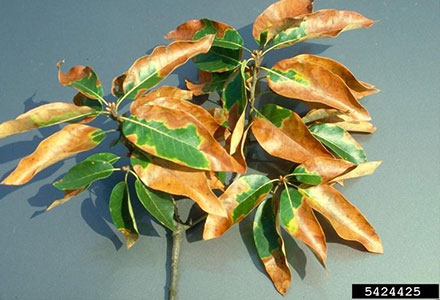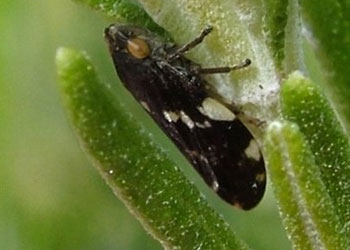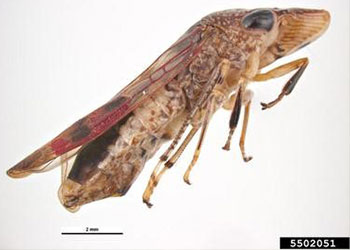PLANT PEST
John Hartman, University of Kentucky, Bugwood.org
Xylella and exotic vectors
Exotic to Australia
Features: A bacterial disease that causes scorched leaves, browning and loss of leaves, stunted shoots, reduced fruit size, dieback and death of many types of plants
Where it's from: Americas originally, now also in China, Europe, Taiwan, Türkiye, Lebanon, Israel, Iran, Iraq, India and the Caribbean
How it spreads: Importation of infected plants and plant material; local spread through insect vectors
At risk: There are over 700 plant host species including native, commercial and ornamental plants
This pest is listed on both the National Priority Plant Pests and the National Priority List of Exotic Environmental Pests, Weeds and Diseases as it has the potential for significant plant industry/agriculture impacts and may also cause significant damage to our environment and social amenity.
Australian Chief Plant Protection Officer, Dr Gabrielle Vivian-Smith, provides an overview of Xylella fastidiosa.
Xylella
Australia’s number one priority plant pest is Xylella fastidiosa.
Xylella causes devastating disease in a wide range of plant species.
This includes many of the crops that we rely on for food and fibre.
Xylella can infect over 350 native, commercial, and ornamental plant species, including wine grapes, olives and fruit and nut trees.
There is no cure for Xylella.
Xylella is spreading around the world and it has had a damaging impact on olive trees and orchards in other countries.
If it arrived in Australia, the consequences would be devastating for our industries, our economy and the environment.
The most likely way that Xylella could make its way to Australia is in infected plant material, or on specific insects that carry and spread Xylella.
As our number one priority plant pest, it is imperative that this disease is kept away from our shores.
We have biosecurity officers, detector dogs and x-ray machines at our borders to ensure that hosts plants and insects that carry Xylella do not arrive with cargo, mail, or passengers.
A National Xylella coordinator has been appointed and a Xylella national action plan is being implemented.
And R&D projects are being funded to support early detection of Xylella if it was to arrive in Australia.
You can do your part by not bringing, sending or purchasing plants from overseas and by keeping an eye out and reporting any plant health risks.
(TEXT AT THE END: Australian Government, Department of Agriculture, Fisheries and Forestry)
Keep it out
If we don’t keep Xylella out, the impacts will be devastating.
Xylella fastidiosa.
You may not have heard of it, but it's one of the world's most destructive plant bacterial diseases.
Australia is free of it right now, but it could change our whole way of life if it makes its way here.
We need everyone's help to keep us safe from this disease.
The most likely way that Xylella could make it to Australia is through people importing infected plant material.
Xylella is Australia's number one National Priority Plant Pest.
This will have a devastating impact across many plants in our food supply, including wine grapes, olives, fruit and nut trees.
There is no cure for Xylella, and the damage is irreversible.
Our everyday life, what we eat, drink and enjoy could be affected.
More than 550 plant species, including native, commercial, and ornamental plants, can be contaminated, and the number is increasing.
The disease does not impact human health but kills plants by damaging their water-conducting system, which shows as leaf scorching.
Xylella is spread by infected insects, human handling of contaminated plant material, and poor equipment hygiene.
Xylella can hibernate for long periods and spreads quickly.
Every year our biosecurity measures prevent Xylella from entering the country.
You can do your part by not bringing, sending or purchasing plants from overseas without following Australia's import requirements.
For more information, head to https://www.agriculture.gov.au/xylella
Xylella [pronounced zy-lella] tops the list of Australia’s National Priority Plant Pests because it causes devastating disease in many species of plants, including many of the crops that we rely on for food and fibre, and there is no cure.
The bacteria (and related subspecies) does not impact human health but kills plants by damaging the water conducting system (xylem) in plants, which shows as leaf scorching.
Xylella infection has several names depending on the plant that’s affected. Commonly it is known as bacterial leaf scorch, but in grapes it is known as Pierce's disease, California vine disease and Anaheim disease. In olive it’s known as olive quick decline, in peach it is called phony disease, and in citrus—variegated chlorosis.
Xylella is spreading around the world, causing significant problems as it kills crops and other plants. In recent years, the Puglia region of southern Italy has seen xylella devastate historically and economically important olive trees and orchards.
The disease could arrive in Australia through:
- importation of infected plants or planting material such as budwood, cuttings and rootstock
- insects infected with the disease. Exotic plant feeding insects are also the subject of biosecurity measures to keep them out of Australia for example meadow spittlebug (Philaenus spumarius) and the glassy winged sharpshooter (Homalodisca vitripennis).
How to keep it out
To keep xylella out of Australia, never ignore Australia’s strict biosecurity rules.
Gardeners
Don’t buy overseas plants or seeds online.
Plate it don’t plant it. Do not plant food products that are intended for eating. Find out more.
Travellers
When travelling overseas check our website to see what you can bring back into Australia and don’t buy plant material items.
Importers
Import shipments may need to be treated and certified, so before you import, check our Biosecurity Import Conditions system (BICON).
What to look for
- Scorching of leaves on plants that advances through the tree or vine.
- The meadow spittlebug and the glassy winged sharpshooter. Spittlebugs are usually less than 13 mm but may be up to 27 mm; while glassy winged sharpshooters are 2-30 mm but average 13 mm.
Cheryl Moorehead, Bugwood.org
Pest and Diseases Image Library, Bugwood.org
Where to look
Importers
The most likely way that xylella could make it to Australia is in infected plant material, including nursery stock or in infected insects.
Growers and home gardeners
- Check your plants frequently for any unexplained leaf scorching.
- Keep an eye out for the exotic insects that can carry the disease.
Damage to crops
Xylella causes disease in more than 700 plants. It affects agricultural crops like:
- citrus
- cherry
- blueberry
- nursery
- nuts
- summerfruit
- grape
- olive
- avocado
- pear.
What to do
- If you think you’ve found symptoms of xylella or one of the exotic insect vectors:
- do not disturb the plant or bug (this may be as simple as closing the doors on a shipping container)
- take a photo
- collect a sample of the infected plant or insect, if possible to do it without disturbing it.
Read the detail
- Plant Health Australia: Pierce’s disease
- Plant Health Australia: bacterial leaf scorch and the glassy winged sharpshooter
- Plant Health Australia: Citrus variegated chlorosis
- Read about the International Symposium on Xylella fastidiosa
- Xylella bacterial pathogens
- Download the National Xylella Action Plan 2019-2029 PDF



